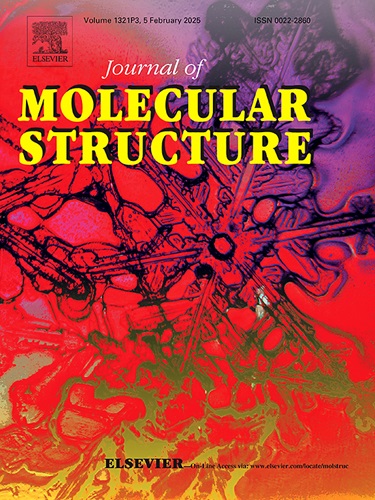Indium Complexes With 2-((Pyridin-4-ylmethylene)amino)phenols: Synthesis, Structure and Spectroscopic Properties
IF 4.7
2区 化学
Q2 CHEMISTRY, PHYSICAL
引用次数: 0
Abstract
Reactions of Schiff base ligands HL1–4 (wherein HL1 is 2-((pyridin-4-ylmethylene)amino)phenol, HL2 is 4-methyl-2-((pyridin-4-ylmethylene)amino)phenol, HL3 is 4‑chloro-2-((pyridin-4-ylmethylene)amino)phenol, HL4 is 4-nitro-2-((pyridin-4-ylmethylene)amino)phenol) with Me3In in a molar ratio of 1:1 lead to the formation of dimethylindium complexes of the general formula (L1–4)InMe2 (1–4). The molecular structures of 1–4 have been determined by single crystal X-ray analysis. In the crystal, all complexes form centrosymmetric dimers via coordination of bridging μ2-O atoms of the phenolate fragment to the metal atom of the neighboring molecule. The crystal packing of 1–4 represents infinite chains due to short contacts between each indium in the dimer and the pyridine nitrogen of the adjacent dimeric molecule. UV–vis absorption spectra of 1–4 have been recorded in various organic solvents. The position of the absorption band assigned to intraligand charge transfer (ILCT) in the UV–vis absorption spectra of 1–4 depends on the nature of the substituent in the phenolate moiety of L1–4 and shifts hypsochromically with increasing of the electron acceptor properties of the substituents in the Schiff bases. The HOMO-LUMO energy gap calculated from the CV measurements for 1–3 also narrows with the introduction of the electron donor substituents in the ligand L. All complexes show fluorescence with broad emission bands in the range of 500–700 nm both in Me-THF solution and in the solid state.

铟与2-((吡啶-4-基亚甲基)氨基)苯酚配合物:合成、结构和光谱性质
希夫碱配体HL1 -4(其中HL1为2-(吡啶-4-基亚甲基)氨基)苯酚,HL2为4-甲基-2-((吡啶-4-基亚甲基)氨基)苯酚,HL3为4-氯-2-((吡啶-4-基亚甲基)氨基)苯酚,HL4为4-硝基-2-((吡啶-4-基亚甲基)氨基)苯酚)与Me3In以1:1的摩尔比反应生成通式(L1-4)InMe2(1-4)的二甲基配合物。通过单晶x射线分析确定了1-4的分子结构。在晶体中,所有配合物都是通过邻分子的金属原子与酚酸酯片段的桥接μ2-O原子的配位形成中心对称的二聚体。由于二聚体中的每个铟与相邻二聚体分子的吡啶氮之间的短接触,1-4的晶体排列代表无限链。在各种有机溶剂中记录了1-4的紫外-可见吸收光谱。在1-4的紫外-可见吸收光谱中,配体内电荷转移(ILCT)的吸收带的位置取决于L1-4的酚酸基团中取代基的性质,并随着席夫碱中取代基电子受体性质的增加而异色转移。通过CV测量计算出的1-3的HOMO-LUMO能隙也随着配体l中电子供体取代基的引入而缩小。所有配合物在Me-THF溶液和固态中都显示出500-700 nm范围内的宽发射带荧光。
本文章由计算机程序翻译,如有差异,请以英文原文为准。
求助全文
约1分钟内获得全文
求助全文
来源期刊

Journal of Molecular Structure
化学-物理化学
CiteScore
7.10
自引率
15.80%
发文量
2384
审稿时长
45 days
期刊介绍:
The Journal of Molecular Structure is dedicated to the publication of full-length articles and review papers, providing important new structural information on all types of chemical species including:
• Stable and unstable molecules in all types of environments (vapour, molecular beam, liquid, solution, liquid crystal, solid state, matrix-isolated, surface-absorbed etc.)
• Chemical intermediates
• Molecules in excited states
• Biological molecules
• Polymers.
The methods used may include any combination of spectroscopic and non-spectroscopic techniques, for example:
• Infrared spectroscopy (mid, far, near)
• Raman spectroscopy and non-linear Raman methods (CARS, etc.)
• Electronic absorption spectroscopy
• Optical rotatory dispersion and circular dichroism
• Fluorescence and phosphorescence techniques
• Electron spectroscopies (PES, XPS), EXAFS, etc.
• Microwave spectroscopy
• Electron diffraction
• NMR and ESR spectroscopies
• Mössbauer spectroscopy
• X-ray crystallography
• Charge Density Analyses
• Computational Studies (supplementing experimental methods)
We encourage publications combining theoretical and experimental approaches. The structural insights gained by the studies should be correlated with the properties, activity and/ or reactivity of the molecule under investigation and the relevance of this molecule and its implications should be discussed.
 求助内容:
求助内容: 应助结果提醒方式:
应助结果提醒方式:


